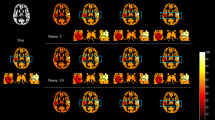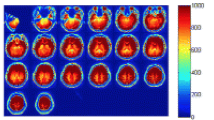Abstract
Arterial spin-labeling (ASL) perfusion MRI is a non-invasive method for quantifying cerebral blood flow (CBF). Standard ASL CBF calibration mainly relies on pair-wise subtraction of the spin-labeled images and controls images at each voxel separately, ignoring the abundant spatial correlations in ASL data. To address this issue, we previously proposed a multivariate support vector machine (SVM) learning-based algorithm for ASL CBF quantification (SVMASLQ). But the original SVMASLQ was designed to do CBF quantification for all image voxels simultaneously, which is not ideal for considering local signal and noise variations. To fix this problem, we here in this paper extended SVMASLQ into a patch-wise method by using a patch-wise classification kernel. At each voxel, an image patch centered at that voxel was extracted from both the control images and labeled images, which was then input into SVMASLQ to find the corresponding patch of the surrogate perfusion map using a non-linear SVM classifier. Those patches were eventually combined into the final perfusion map. Method evaluations were performed using ASL data from 30 young healthy subjects. The results showed that the patch-wise SVMASLQ increased perfusion map SNR by 6.6% compared to the non-patch-wise SVMASLQ.




Similar content being viewed by others
References
Detre JA et al (1992) Perfusion imaging. Magn Reson Med 23(1):37–45
Williams DS et al (1992) Magnetic resonance imaging of perfusion using spin inversion of arterial water. Proc Natl Acad Sci 89(1):212–216
Dolui S et al (2016) Structural correlation-based outlier rejection (SCORE) algorithm for arterial spin labeling time series. J Magn Reson Imaging 45(6):1786–1797
Chen JJ, Jann K, Wang DJ (2015) Characterizing resting-state brain function using arterial spin labeling. Brain connectivity 5(9):527–542
Liu X et al (2016) Three-dimensional hemodynamics analysis of the circle of Willis in the patient-specific nonintegral arterial structures. Biomech Model Mechanobiol 15(6):1439–1456
Mohb Adib MA et al (2017) Minimizing the blood velocity differences between phase-contrast magnetic resonance imaging and computational fluid dynamics simulation in cerebral arteries and aneurysms. Med Biol Eng Comput, p. 1–15
Alsop DC et al (2015) Recommended implementation of arterial spin-labeled perfusion MRI for clinical applications: a consensus of the ISMRM perfusion study group and the European consortium for ASL in dementia. Magn Reson Med 73(1):102–116
Wong EC (1999) Potential and pitfalls of arterial spin labeling based perfusion imaging techniques for MRI, in Functional MRI. C.T.W.M.a.P.A. Bandettini (Ed) New York. p. 63–69
Wang Z et al (2008) Empirical optimization of ASL data analysis using an ASL data processing toolbox: ASLtbx. Magn Reson Imaging 26(2):261–269
Wang Z (2012) Improving cerebral blood flow quantification for arterial spin labeled perfusion MRI by removing residual motion artifacts and global signal fluctuations. Magn Reson Imaging 30(10):1409–1415
Restom K, Behzadi Y, Liu TT (2006) Physiological noise reduction for arterial spin labeling functional MRI. NeuroImage 31(3):1104–1115
Behzadi Y et al (2007) A component based noise correction method (CompCor) for BOLD and perfusion based fMRI. NeuroImage 37(1):90–101
Power JD et al (2012) Spurious but systematic correlations in functional connectivity MRI networks arise from subject motion. NeuroImage 59(3):2142–2154
Fang R, Huang J, Luh W-M (2015) A spatio-temporal low-rank total variation approach for denoising arterial spin labeling MRI data. IEEE 12th International Symposium on Biomedical Imaging (ISBI) 2015:498–502
Glover GH, Li TQ, Ress D (2000) Image-based method for retrospective correction of physiological motion effects in fMRI: RETROICOR. Magn Reson Med 44(1):162–167
Bibic A et al (2010) Denoising of arterial spin labeling data: wavelet-domain filtering compared with Gaussian smoothing. MAGMA 23(3):125–137
Wells JA et al (2010) Reduction of errors in ASL cerebral perfusion and arterial transit time maps using image de-noising. Magn Reson Med 64(3):715–724
Wang Z (2014) Support vector machine learning-based cerebral blood flow quantification for arterial spin labeling MRI. Hum Brain Mapp 35(7):2869–2875
Cox DD, Savoy RL (2003) Functional magnetic resonance imaging (fMRI) “brain reading”: detecting and classifying distributed patterns of fMRI activity in human visual cortex. NeuroImage 19(2):261–270
LaConte S et al (2005) Support vector machines for temporal classification of block design fMRI data. NeuroImage 26(2):317–329
Mourão-Miranda J et al (2005) Classifying brain states and determining the discriminating activation patterns: support vector machine on functional MRI data. NeuroImage 28(4):980–995
Mourão-Miranda J, Fristonb KJ, Brammer M (2007) Dynamic discrimination analysis: a spatial-temporal SVM. NeuroImage 36(1):88–99
Mourão-Miranda J et al (2006) The impact of temporal compression and space selection on SVM analysis of single-subject and multi-subject fMRI data. NeuroImage 33:1055–1065
Fan Y et al (2007) Multivariate examination of brain abnormality using both structural and functional MRI. NeuroImage 36:1189–1199
Wang Z et al (2007) Support vector machine learning-based fMRI data group analysis. NeuroImage 36(4):1139–1151
Wang Z (2009) A hybrid SVM-GLM approach for fMRI data analysis. NeuroImage 46(3):608–615
Wang Z et al (2008) Assessment of functional development in normal infant brain using arterial spin labeled perfusion MRI. NeuroImage 39(3):973–978
Mirman D et al (2015) Neural organization of spoken language revealed by lesion-symptom mapping. Nat Commun 6:6762
Mirman D et al (2015) The ins and outs of meaning: behavioral and neuroanatomical dissociation of semantically-driven word retrieval and multimodal semantic recognition in aphasia. Neuropsychologia 76:208–219
Zhang Y et al (2014) Multivariate lesion-symptom mapping using support vector regression. Hum Brain Mapp 35(12):5861–5876
Kim KH, Bang SW, Kim SR (2004) Emotion recognition system using short-term monitoring of physiological signals. Med Biol Eng Comput 42(3):419–427
Kumar S et al (2015) Support vector machine and fuzzy C-mean clustering-based comparative evaluation of changes in motor cortex electroencephalogram under chronic alcoholism. Med Biol Eng Comput 53(7):609–622
Dai W et al (2008) Continuous flow-driven inversion for arterial spin labeling using pulsed radio frequency and gradient fields. Magn Reson Med 60(6):1488–1497
Chang C-C, Lin C-J (2011) LIBSVM: a library for support vector machines. ACM Transactions on Intelligent Systems and Technology (TIST) 2(3):27
Wang J et al (2003) Arterial spin labeling perfusion fMRI with very low task frequency. Magn Reson Med 49(5):796–802
Buades A, Coll B, Morel J-M (2005) A non-local algorithm for image denoising. In 2005 I.E. Computer Society Conference on Computer Vision and Pattern Recognition (CVPR’05). IEEE
Vorontsov E et al (2017) Metastatic liver tumour segmentation with a neural network-guided 3D deformable model. Med Biol Eng Comput 55(1):127–139
Zhu H et al (2017) Metric learning for multi-atlas based segmentation of hippocampus. Neuroinformatics 15(1):41–50
Yang J et al (2010) Image super-resolution via sparse representation. IEEE Trans Image Process 19(11):2861–2873
Rueda A, Malpica N, Romero E (2013) Single-image super-resolution of brain MR images using overcomplete dictionaries. Med Image Anal 17(1):113–132
Aguirre G et al (2002) Experimental design and the relative sensitivity of BOLD and perfusion fMRI. NeuroImage 15(3):488–500
Acknowledgements
This study was supported by the National Natural Science Foundation of China (No. 61602307, 61671198), Natural Science Foundation of Zhejiang Province Grant LZ15H180001, the Youth 1000 Talent Program of China, Hangzhou Qianjiang Endowed Professor Program, and Hangzhou Innovation Seed Fund.
Author information
Authors and Affiliations
Corresponding author
Rights and permissions
About this article
Cite this article
Zhu, H., He, G. & Wang, Z. Patch-based local learning method for cerebral blood flow quantification with arterial spin-labeling MRI. Med Biol Eng Comput 56, 951–956 (2018). https://doi.org/10.1007/s11517-017-1735-6
Received:
Accepted:
Published:
Issue Date:
DOI: https://doi.org/10.1007/s11517-017-1735-6




